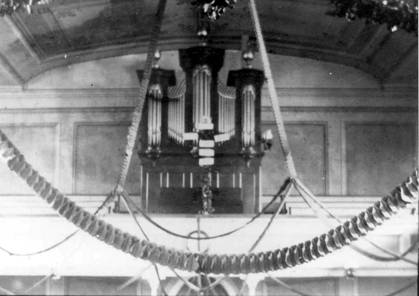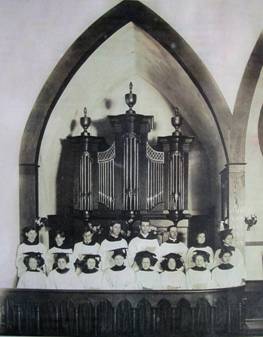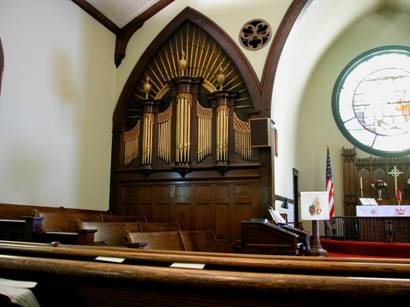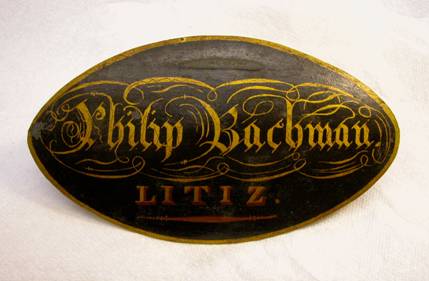
A printable version of this document is available
|
Prospectus – 1819 Organ by Philip Bachman: A rare opportunity exists for the purchase and installation of an organ dating from the first quarter of the 19th century that has been meticulously recreated from extant original parts and thorough research. The organ and its history are described in detail below. Ideally the reconstructed organ will find a permanent home in a beautiful architectural and acoustical setting where the organ will be regularly seen and heard by audiences. A university location in an art gallery or similar space where practice time and concerts could be judiciously scheduled and where students could have access would be perfect. This is a museum-quality artifact. The desirability of the potential location can influence the price of the organ favorably. The pedigree of the organ and the quality of its extant parts set hopes high for the outcome of its reconstruction. Now complete, the visual and musical results have far exceeded all expectations. The organ has a special “old” sound that is hard to obtain and difficult to describe with words. Key and stop actions and winding system components are also historically accurate and provide an authentic experience of playing an antique American-built organ. Please contact Paul Fritts & Company Organ Builders for more information. History of the Organ: Paul Fritts & Company Organbuilders in Tacoma, Washington, has reconstructed from extant parts an organ originally built in 1819 by Philip Bachman, son-in-law of David Tannenberg, America’s first native-trained organbuilder. Tannenberg and Bachman worked together in Lititz, Pennsylvania from 1793 until 1800 when Bachman began to work independently as an instrument maker. It appears that he built 10 organs as well as a number of other stringed keyboard instruments between 1802 and 1821. The reconstructed organ contains the sole remnants of Bachman’s organbuilding. At least one Bachman pianoforte survives as well.
The organ was built at the outset for Friedens Lutheran Church in Myerstown, Pennsylvania and was dedicated Easter Sunday, April 11, 1819. The church purchased a new organ in 1901, leaving the old organ in place where it continued to be used occasionally. When the church’s interior was remodeled in 1908, the old organ was removed. At that time, a former member who had moved to Tacoma, Washington found out that the old organ was available and his church, St. John’s English Lutheran Church, asked if they could obtain the instrument. The Pennsylvania church agreed to donate the organ to the Tacoma church provided the latter would pay for the associated shipping costs. It was dismantled and packed for shipment. There are unsubstantiated reports that the organ traveled by ship all the way around the southern tip of South America to Tacoma. (The Panama Canal was not completed until 1914.) When the organ arrived in Tacoma, “it was found to be a single manual hand-pumped organ.” A local organ technician reassembled the organ at St. John’s and “added a pedal bass.” The organ was used in the church (apparently still as a solely hand-pumped instrument) from its dedication in November 1910, until Easter Sunday, April 16, 1933.
In keeping with the times, and no doubt desiring to have two manuals, a larger and more modern organ was sought by St. John’s. “In March, 1932, a contract was entered into for rebuilding and electrifying the organ – total price $1800. It was at that time converted into a two-manual organ.” Most of the original Bachman organ was discarded with the original upper case front and façade pipes being retained as a front for the pipe chamber of the electric-action organ. Fortunately several other important components of the old organ were also preserved including the upper section of the detached console with its original ivory keyboard and Bachman’s nameplate. This portion of the organ was displayed for a time at the State Museum of Washington in Tacoma before being returned to the church. The original stop rods are present although the stop knobs and labels were changed, probably when the pedals were added so that all the stop knobs would match. Factory-made oblique face knobs from the turn of the century were used and the labels displayed late 19th century nomenclature. It is not certain what the stops had been labeled originally. There is no sign of previous stop labels on the stop jamb fronts, so any original labels must have been on the knobs. Four wooden stop trees from the console and the original bottom board of the windchest pallet box are also extant from the Bachman organ. The latter is a particularly fortuitous artifact as it definitively displays the channel center spacing of the original windchest channels. The order of the channels on the windchest can be deduced from the pallet box bottom together with the corresponding façade pipes (the order for which were numbered). A total of 82 metal pipes are preserved including all 29 of the original façade pipes which has the 15 lowest pipes (C-d) of the Principal Octav 4’ displayed in the three rounded towers and 14 pipes (ds-e’) of the Principal Dulcis 8’ in the two flat fields of pipes. The organ originally had just over 500 pipes.
St. John’s Lutheran Church in Tacoma merged with Our Saviour’s Lutheran in 1932 and became Luther Memorial Church. Dwindling membership caused the church to close in 2004 and at that time the Bachman organ parts were removed to storage at the Fritts organ shop. Since then, the organ has been thoroughly researched and plans for its reconstruction were carefully developed from the existing parts and available historical information. As originally built, the organ had much in common with the 1802 Tannenberg organ at Hebron Lutheran Church in Madison, VA, which is one of the best preserved of the Tannenberg organs. Bachman helped build and installed the Madison organ for the aging Tannenberg and was thoroughly familiar with the organ and its design. The façade proportions and other measurements and the layouts of the two organs are very similar as are the windchest and rollerboard layouts. Since Bachman inherited Tannenberg’s organbuilding papers, it is quite likely that the organ was built using Tannenberg’s drawings for the Madison organ as the starting point. For that reason, the largely unaltered Madison Tannenberg provides a valuable model for the missing parts of the Bachman organ. There were only two significant differences in the organs: Madison had its keydesk built into the lower case while the Bachman organ had a separate detached and reversed console; and the Bachman organ has a third 8’ stop, a Quintadena 8’, where the Madison organ had a Terz. Insofar as possible, all of the original pieces of the Bachman organ have been restored and used in the reconstructed instrument including the gilded pipe shades. The organ almost certainly did not originally have pedals although a pedal keyboard and one stop of pipes were added to the organ at some point – reportedly when the organ was originally installed in Tacoma. That pedalboard with a compass of 18 notes (C-f) has been preserved. This pedalboard seems to be older than 1908 but is in good condition. Its small compass would have been a limitation for the restored and reconstructed organ so it was used as a model for a new 27-note (C-d’) pedalboard. The 1800 Salem Tannenberg already had a 25-note pedalboard so 27 notes seems to be a good compass for an organ built 20 years later. The organ has been reconstructed with the 27-note pedal and wooden Subbass 16’ and also has a Manual to Pedal coupler. These additions do not affect the original portion of the organ related to the single keyboard, which can be authentically represented by playing on the manual alone. The organ represents a unique portion of American organbuilding and is the sole remaining example of Bachman’s organbuilding. The preserved parts constitute the oldest extant organ remnants in the State of Washington. The restored and reconstructed organ is believed to represent accurately the tonal and physical characteristics of an early 19th century American-built organ.
Philip Bachman Organ built in 1819 - Friedens Lutheran Church, Myerstown, Pennsylvania
Also serving St. John’s Lutheran Church (later Luther Memorial Church) in Tacoma, Washington from 1908-33 Manual: C – f’’’ 54 notes 8’ Principal Dulcis (ds – e’ in façade) – 14 original pipes Pedal: C – d’ 27 notes 16’ Subbass (wooden pipes) Manual to Pedal coupler
Church History St. John’s/Luther Memorial Church Archives of the Moravian Church and Moravian Music Foundation and MESDA in Salem, NC That Ingenious Business – Pennsylvania German Organ Builders by Raymond J. Brunner, The Pennsylvania German Society 1990 Organs for America by William Armstrong, University of Pennsylvania, Philadelphia 1967 Splendid Service, The Restoration of David Tannenberg’s Home Moravian Church Organ by William Armstrong, Paula Locklair, and Bruce Shull, edited by Gary Albert 9 Extant Tannenberg organs – in particular the 1802 organ at Hebron Lutheran Church in Madison, Virginia Eastern white pine lumber carefully sawn and air-dried – supplied by John Boody of Taylor & Boody Organbuilders, Staunton, Virginia Metal analysis by MSI Testing and Engineering, Melrose Park, IL Special large-headed wood screws for the windchest toeboards donated by Ryan Albashian from Dresden, Germany Assistance with façade pipe restoration from Robbie Lawson from Taylor & Boody Ivory stop knob faces from Harris Precision Products, Whittier, CA Combined expertise of the Fritts workshop staff: Bruce Shull Research and design; project management; wood pipe construction; stop action construction; voicing and tuning of all pipes (blending new pipework with extant pipes); restoration and re-gilding of pipe shade carvings Andreas Schonger Case construction and painting; windchest construction; Subbass 16’ pipe construction; windline construction Raphi Giangulio Rollerboard and key action construction; coupler construction Ricky Frith Stop action steel fabrication; metal pipe construction Erik McLeod Pipe restoration; pipe metal casting; metal pipe construction Greg Bahnsen Metal pipe construction; stop knob turning; case impost finial turning Paul Fritts Pipe scaling; engraving; workshop management
|






 The original nameplate from the Bachman organ console
The original nameplate from the Bachman organ console The restored 1819 Bachman organ in the Fritts workshop
The restored 1819 Bachman organ in the Fritts workshop